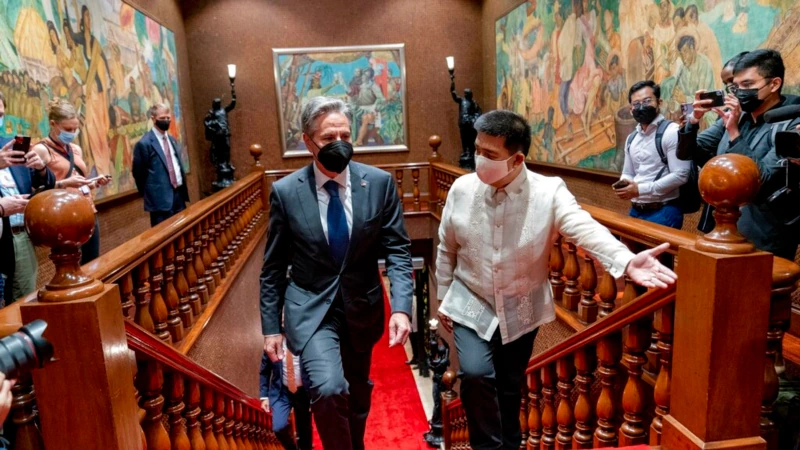U.S. Secretary of State Antony Blinken Saturday met with new Philippine President Ferdinand Marcos Jr. to reaffirm ties with America’s oldest treaty ally in Asia amid rising tensions in the “volatile” region.
Blinken said America’s relationship with the Philippines is “extraordinary” and assured the Philippines of its readiness to work with Southeast Asian nation in areas of defense, climate change and controlling the COVID-19 pandemic.
Blinken, the highest U.S. official to visit the Philippines since Marcos clinched a landslide victory in May, reaffirmed America’s commitment to its 1951 defense pact with the Philippines.
“We’re committed to the Mutual Defense Treaty. We’re committed to working with you on shared challenges,” he told Marcos in brief remarks.
Welcoming Blinken at the presidential palace, Marcos said the top U.S. diplomat’s visit was timely, as he expressed concern over increasing tensions between China and Taiwan over the recent visit of House Speaker Nancy Pelosi to the self-governing island.
“I did not think it raised the intensity; it just demonstrated how the intensity of the conflict has been,” Marcos told Blinken before their private meeting.
China launched retaliatory measures against Taiwan over Pelosi’s visit, conducting live-fire exercises. Taiwan is the Philippines’ closest neighbor and is a home to thousands of Philippine migrant workers.
At home, though, the Philippines is dealing with Beijing’s increasing militarization and encroachment in part of the South China Sea that is claimed by the Philippines, where Chinese coast guard and militia vessels constantly harass Philippine fishermen and shadow research boats.
“Our relationship is quite extraordinary because it is really founded in friendship, it’s forged as well in partnership, and it’s strengthened by the fact that it’s an alliance as well,” Blinken told Marcos.
Evolution of treaty
Marcos said the Philippines treaty alliance with the U.S. is a “constant evolution.”
“I hope that we will continue to evolve that relationship in the face of all the changes that we have been seeing and the changes that are between our bilateral relationship with the United States,” he said.
The Philippines is an important and strategic U.S. ally in Southeast Asia as it faces stiff competition with China’s power around the world.
Blinken’s visit is the latest U.S. effort to woo the Philippines after relations soured during the administration of President Rodrigo Duterte, whose pivot to China led to empty promises of infrastructure and investment from Beijing.
In 2020, Duterte initially ordered the abrogation of the U.S.-Philippine Visiting Forces Agreement, an integral component of the treaty that allows U.S. soldiers on Philippine soil for routine visits. Duterte ordered its reinstatement a year later.
Dialogue with China
Foreign Secretary Enrique Manalo, in a dialogue with Blinken, reiterated Philippines’ call on China and the U.S. to defuse the tension in the region.
“The Philippines continues, of course, to look at big powers, to help calm the waters and keep peace,” Manalo told Blinken in a separate virtual meeting.
“We can ill afford any further escalation of tensions in the region, because we are already facing a number of challenges getting our economy back to work, especially because of the COVID-19 pandemic,” he added.

